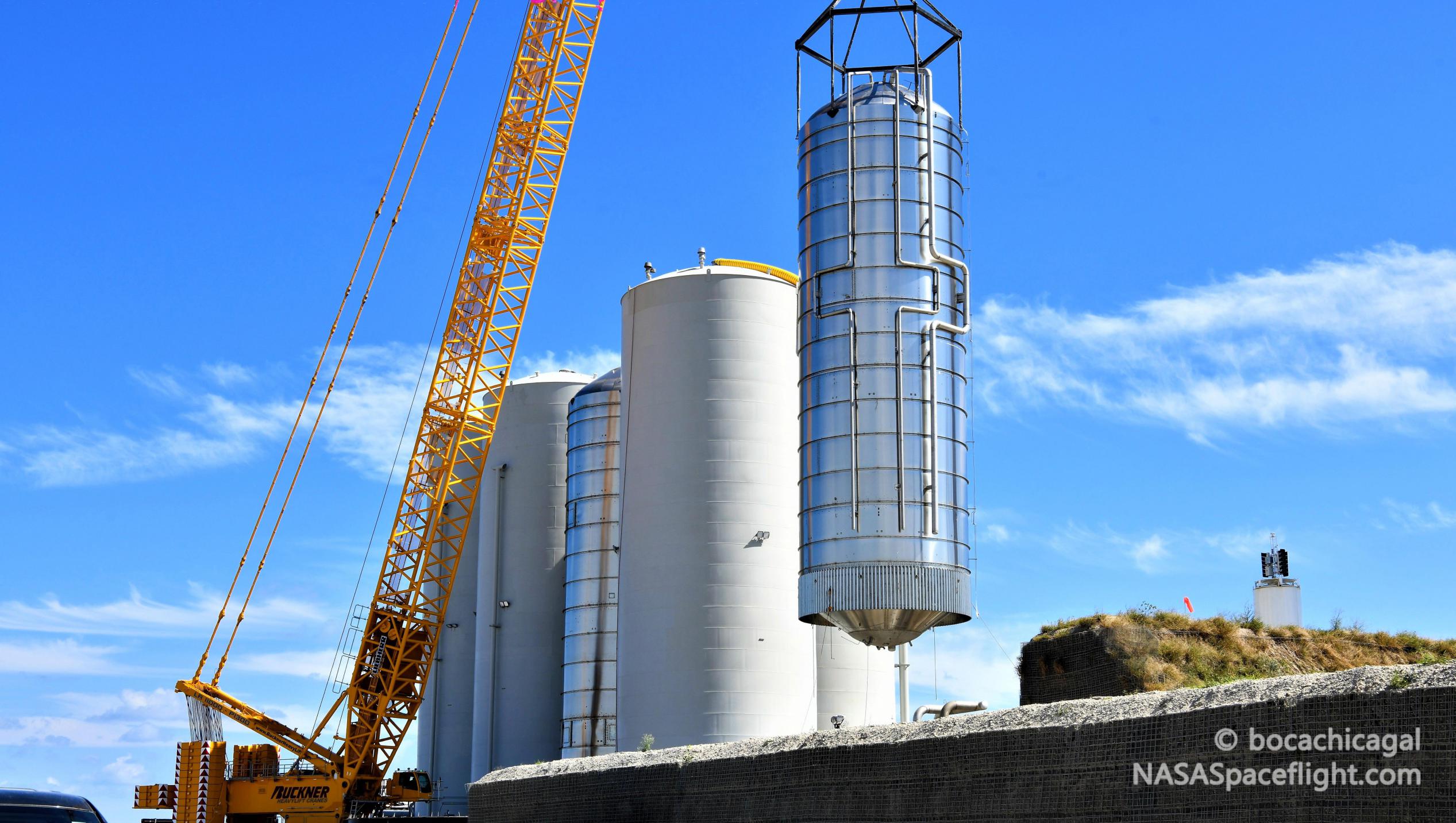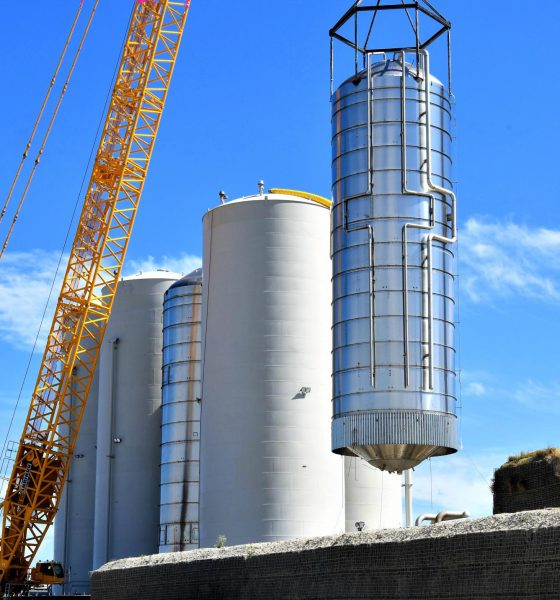

News
SpaceX’s first orbital-class Starship ‘tank farm’ is almost finished
Roughly six months after the process began, SpaceX has installed the seventh and final custom-built propellant storage tank at Starbase’s first orbital-class Starship launch site.
Built out of the same factory and parts as the steel tanks that make up most of the two-stage Starship rocket’s structure, SpaceX completed the first two of those ‘ground support equipment (GSE)’ tanks in April and wasted no time installing both at Starbase’s orbital launch site (OLS). However, after a strong start, GSE tank work seemingly halted for several months and it wasn’t until August that SpaceX first enclosed one of the then three installed tanks with a sleeve designed to insulate their cryogenic contents. Since then, progress has picked back up and SpaceX has built and installed another three (for a total of six) storage tanks over the last two months.
That work effectively culminated on September 7th with the transport of the farm’s seventh and final GSE tank from build site to launch pad.
Unintuitively known as GSE-8 after SpaceX chose to scrap one of the original seven planned tanks earlier this year, the company wasted no time installing it shortly after its two-mile trip down the highway. GSE-8 is the second of two liquid methane (LCH4) tanks now installed at the orbital launch site and joins another three liquid oxygen (LOx) and two liquid nitrogen (LN2) tanks for a total of seven.
Combined, the OLS tank farm should be able to store more than 2400 tons of LCH4 and 4000 tons of LOx, as well as 2600+ tons of LN2 to be used for ‘subcooling’ (and thus densifying) that propellant well below its boiling point. Ultimately, that means that despite the massive scale of Starbase’s first orbital-class tank farm, it will still only hold enough propellant for a single orbital Starship launch and have to be almost fully restocked after each flight.
Given the logistical nightmare of arranging something like 100+ tanker trucks for each tank farm ‘refill,’ a process that could easily take a week or more on its own, it should come as no surprise that SpaceX is also building a dedicated liquid oxygen and nitrogen plant adjacent to its Starbase factory. On top of liquid natural gas (LNG) refinery and tenuous plans to potentially tap local natural gas wells, SpaceX is clearly well aware of the logistical challenges of regular Starship launches.
While there are no clear signs of the inevitable permitting and environmental reviews it would require, it’s likely that SpaceX will eventually create a brief above or below-ground cryogenic pipeline connecting its propellant factory to Starbase’s orbital launch site(s). If or when implemented, that would allow SpaceX to resupply its two planned orbital tank farms with minimal effort or human intervention beyond the process of producing the propellant.


For the time being, SpaceX will likely rely on a slow but simple parade of tanker trucks to gradually fill its first orbital tank farm. Before even that process is possible, though, SpaceX will need to finish plumbing GSE-8 and several other tanks, install the last two insulative ‘cryoshells,’ and finally fill the annuli between all seven tanks and their shells with an insulative foam-like material known as perlite. Dozens of bags of perlite and several kilns (used to expand the material into low density insulation) are already distributed around the orbital tank farm.
Meanwhile, SpaceX also continues to slowly fill the first two completed OLS tanks (nominally meant to hold LOx) with liquid nitrogen, serving both to test the tanks and pad plumbing and to clean their interiors for liquid oxygen service. Ultimately, while a good amount of work remains, Starbase’s first orbital-class tank farm could be fully ready to support its first Super Heavy booster proof and static fire test campaign just a few weeks from now.

News
Tesla China quietly posts Robotaxi-related job listing
Tesla China is currently seeking a Low Voltage Electrical Engineer to work on circuit board design for the company’s autonomous vehicles.

Tesla has posted a new job listing in Shanghai explicitly tied to its Robotaxi program, fueling speculation that the company is preparing to launch its dedicated autonomous ride-hailing service in China.
As noted in the listing, Tesla China is currently seeking a Low Voltage Electrical Engineer to work on circuit board design for the company’s autonomous vehicles.
Robotaxi-specific role
The listing, which was shared on social media platform X by industry watcher @tslaming, suggested that Tesla China is looking to fill the role urgently. The job listing itself specifically mentions that the person hired for the role will be working on the Low Voltage Hardware team, which would design the circuit boards that would serve as the nervous system of the Robotaxi.
Key tasks for the role, as indicated in the job listing, include collaboration with PCB layout, firmware, mechanical, program management, and validation teams, among other responsibilities. The role is based in Shanghai.
China Robotaxi launch
China represents a massive potential market for robotaxis, with its dense urban centers and supportive policies in select cities. Tesla has limited permission to roll out FSD in the country, though despite this, its vehicles have been hailed as among the best in the market when it comes to autonomous features. So far, at least, it appears that China supports Tesla’s FSD and Robotaxi rollout.
This was hinted at in November, when Tesla brought the Cybercab to the 8th China International Import Expo (CIIE) in Shanghai, marking the first time that the autonomous two-seater was brought to the Asia-Pacific region. The vehicle, despite not having a release date in China, received a significant amount of interest among the event’s attendees.
Elon Musk
Elon Musk and Tesla AI Director share insights after empty driver seat Robotaxi rides
The executives’ unoccupied tests hint at the rapid progress of Tesla’s unsupervised Robotaxi efforts.

Tesla CEO Elon Musk and AI Director Ashok Elluswamy celebrated Christmas Eve by sharing personal experiences with Robotaxi vehicles that had no safety monitor or occupant in the driver’s seat. Musk described the system’s “perfect driving” around Austin, while Elluswamy posted video from the back seat, calling it “an amazing experience.”
The executives’ unoccupied tests hint at the rapid progress of Tesla’s unsupervised Robotaxi efforts.
Elon and Ashok’s firsthand Robotaxi insights
Prior to Musk and the Tesla AI Director’s posts, sightings of unmanned Teslas navigating public roads were widely shared on social media. One such vehicle was spotted in Austin, Texas, which Elon Musk acknowleged by stating that “Testing is underway with no occupants in the car.”
Based on his Christmas Eve post, Musk seemed to have tested an unmanned Tesla himself. “A Tesla with no safety monitor in the car and me sitting in the passenger seat took me all around Austin on Sunday with perfect driving,” Musk wrote in his post.
Elluswamy responded with a 2-minute video showing himself in the rear of an unmanned Tesla. The video featured the vehicle’s empty front seats, as well as its smooth handling through real-world traffic. He captioned his video with the words, “It’s an amazing experience!”
Towards Unsupervised operations
During an xAI Hackathon earlier this month, Elon Musk mentioned that Tesla owed be removing Safety Monitors from its Robotaxis in Austin in just three weeks. “Unsupervised is pretty much solved at this point. So there will be Tesla Robotaxis operating in Austin with no one in them. Not even anyone in the passenger seat in about three weeks,” he said. Musk echoed similar estimates at the 2025 Annual Shareholder Meeting and the Q3 2025 earnings call.
Considering the insights that were posted Musk and Elluswamy, it does appear that Tesla is working hard towards operating its Robotaxis with no safety monitors. This is quite impressive considering that the service was launched just earlier this year.
Elon Musk
Starlink passes 9 million active customers just weeks after hitting 8 million
The milestone highlights the accelerating growth of Starlink, which has now been adding over 20,000 new users per day.

SpaceX’s Starlink satellite internet service has continued its rapid global expansion, surpassing 9 million active customers just weeks after crossing the 8 million mark.
The milestone highlights the accelerating growth of Starlink, which has now been adding over 20,000 new users per day.
9 million customers
In a post on X, SpaceX stated that Starlink now serves over 9 million active users across 155 countries, territories, and markets. The company reached 8 million customers in early November, meaning it added roughly 1 million subscribers in under seven weeks, or about 21,275 new users on average per day.
“Starlink is connecting more than 9M active customers with high-speed internet across 155 countries, territories, and many other markets,” Starlink wrote in a post on its official X account. SpaceX President Gwynne Shotwell also celebrated the milestone on X. “A huge thank you to all of our customers and congrats to the Starlink team for such an incredible product,” she wrote.
That growth rate reflects both rising demand for broadband in underserved regions and Starlink’s expanding satellite constellation, which now includes more than 9,000 low-Earth-orbit satellites designed to deliver high-speed, low-latency internet worldwide.
Starlink’s momentum
Starlink’s momentum has been building up. SpaceX reported 4.6 million Starlink customers in December 2024, followed by 7 million by August 2025, and 8 million customers in November. Independent data also suggests Starlink usage is rising sharply, with Cloudflare reporting that global web traffic from Starlink users more than doubled in 2025, as noted in an Insider report.
Starlink’s momentum is increasingly tied to SpaceX’s broader financial outlook. Elon Musk has said the satellite network is “by far” the company’s largest revenue driver, and reports suggest SpaceX may be positioning itself for an initial public offering as soon as next year, with valuations estimated as high as $1.5 trillion. Musk has also suggested in the past that Starlink could have its own IPO in the future.








